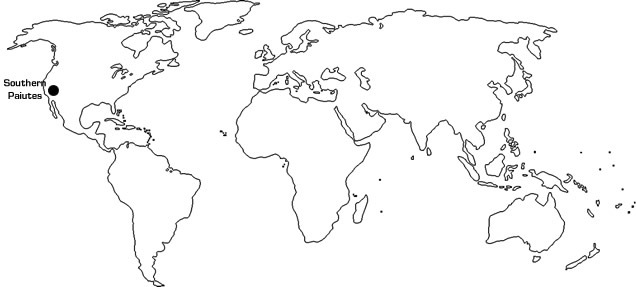 |
|
Alternative Lifeways Across Space & Time
North America
Inuit
Pacific Northwest Indians
Hutterites
Sioux
Old Order Amish
Southern Paiutes
Puebloans
The Farm
Hot Springs Ranch
Apaches
Maya
Zapotec of La Paz
South America
Piaroa
Quechoa
Inca
Europe & Atlantic
Scottish Highlanders
Irish Farming Villages
Dark Ages Europe
Alpine Pastoralists
Alpujarra
Roman Empire
Tristan Islanders
Africa
Ancient Egypt
Nubians
Jenne-Jeno
Post-Colonial Africa
Samburu
Fipa
Bushmen
Asia & Pacific
Iranian Nomads
Ladakhi
Lepchas
Chinese Society
Hadhramaut
Indian Society
Birhor
Kadar
Malapandaram
Paliyans
Yanadi
Rural Thai
Batek
Semai
Buid
Chewong
Yap Islanders
Ifaluk
Bali Rice Culture
New Guinea Highlanders
Tahitians
Australian Aborigines
|
|
|
 |
 |
 |
 |
 |
|
|
|
 |
|
To be updated!

|
|
 |
|
World & Ecology
Southern Paiutes are very sparsely distributed throughout a generally arid region of the North American Southwest which encompasses a variety of terrain and ecosystems, including extreme desert basins and mountain ranges, semi-arid mountains and valleys, river canyons, high forested plateaus, and high mountains with alpine habitat. Their habitat was historically remote from population or trading centers used by other societies, but the development of Las Vegas has placed a large Anglo-European population in their midst.
Although they sometimes returned to semi-permanent shelters during their annual migrations, they primarily lived outdoors, in the open, or in temporary shelters made from nearby materials and abandoned.
Southern Paiutes were historicaly one of the lowest-impact societies on earth, along with African Bushmen and Australian Aborigines. All of their technology was made by hand using local resources; all semi-permanent implements were transportable by foot or cached for return use; temporary items were made quickly for use on the spot and abandoned.
Resources for meeting basic needs are extremely diverse due to the diversity of ecosystems in their territory. Historically, Southern Paiutes migrated on foot throughout their territory seasonally and at longer intervals as resources (primarily food) became available in various places, and to cultivate floodplain gardens, and to visit friends and relatives.
Like many traditional societies, their subsistence encompassed foraging, gardening, hunting, and trade, but did not depend more on some activities than others, so they always had options. |
|
 |
|
Top
|
|
 |
|
Society
Southern Paiute society is extremely egalitarian and peaceful. They do not support strong leaders, nor do they have a tradition of aggression. During their nomadic history, it was usually easy for Paiutes to migrate to avoid conflict, and that's what they did.
The structure of their small, migratory groups evolved from place to place and season to season. These temporary groups consisted of opportunistic partnerships of extended families and others with similar interests or needs. Each day began with consensual planning of the day's work or play, ranging from individual or group foraging or hunting trips, to craft work, to preparation for a migration. Groups merged or split up as needed, often without much planning, and, often at regular times of year, groups traveled to a gathering place for socializing, memorials, celebrations, singing, dancing, and games.
Paiute men and women often met at regular annual gatherings, and consensually began living together as man and wife. With a nomadic life, Paiute mothers gave birth in temporary camps, and children were cared for communally by elders and raised by working adults as they worked, so that they acquired survival skills automatically. Traditional knowledge and wisdom were handed down in stories and songs around the winter campfires. The dead were abandoned or cremated along with their possessions; their spirits joined the ancestors; their knowledge and wisdom remained with the group. |
|
 |
|
Top
|
|
 |
|
Time & History
Southern Paiute habitats display strong seasonal cycles of productivity, and Paiutes monitored resources and moved with the seasons as plant and animal resources became available in different places. However, many resources, such as pine nuts, became available only at longer, unpredictable intervals, so Paiutes did not have a true seasonal routine; their migrations were opportunistic and adventurous from year to year.
As in any traditional society, wisdom consisted largely in how to adapt to major environmental changes that occurred unpredictably at long intervals. This wisdom was naturally cultivated by elders who had lived long enough to experience these challenges: earthquakes, fires, floods, invasions, etc. As with other peaceful societies, the primary Paiute response was to migrate to avoid conflict, rather than fighting to control or defend territory. |
|
 |
|
Top
|
|
 |
|
Previous | Next |
|
|